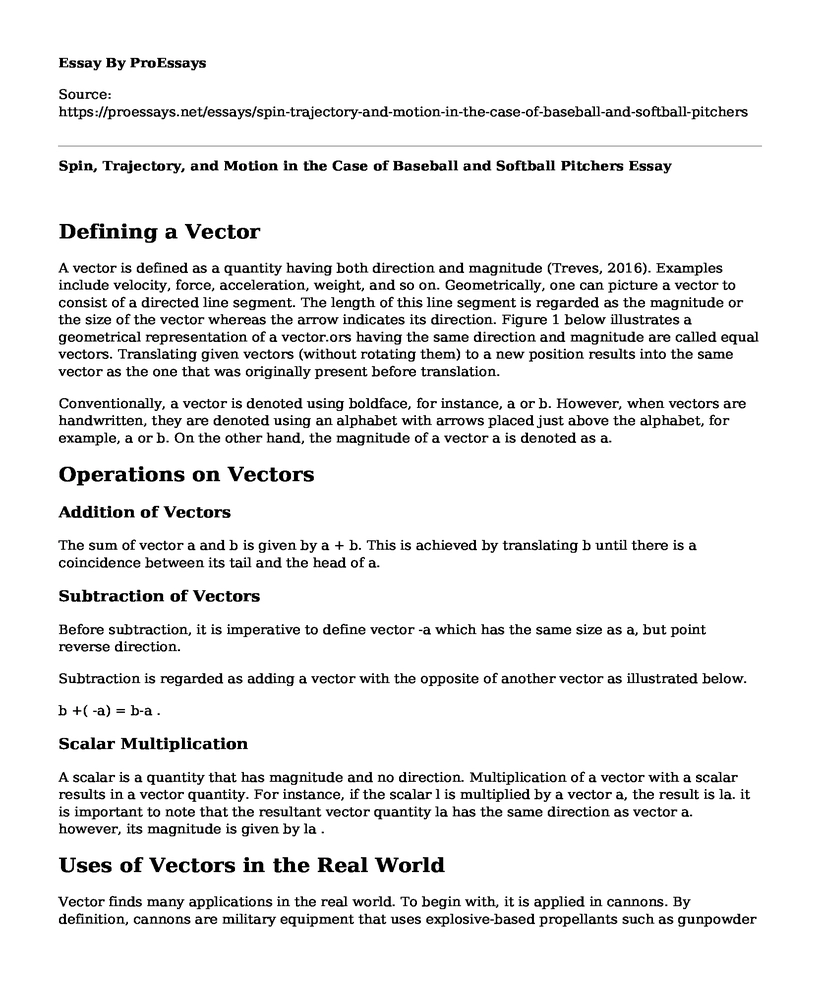Defining a Vector
A vector is defined as a quantity having both direction and magnitude (Treves, 2016). Examples include velocity, force, acceleration, weight, and so on. Geometrically, one can picture a vector to consist of a directed line segment. The length of this line segment is regarded as the magnitude or the size of the vector whereas the arrow indicates its direction. Figure 1 below illustrates a geometrical representation of a vector.ors having the same direction and magnitude are called equal vectors. Translating given vectors (without rotating them) to a new position results into the same vector as the one that was originally present before translation.
Conventionally, a vector is denoted using boldface, for instance, a or b. However, when vectors are handwritten, they are denoted using an alphabet with arrows placed just above the alphabet, for example, a or b. On the other hand, the magnitude of a vector a is denoted as a.
Operations on Vectors
Addition of Vectors
The sum of vector a and b is given by a + b. This is achieved by translating b until there is a coincidence between its tail and the head of a.
Subtraction of Vectors
Before subtraction, it is imperative to define vector -a which has the same size as a, but point reverse direction.
Subtraction is regarded as adding a vector with the opposite of another vector as illustrated below.
b +( -a) = b-a .
Scalar Multiplication
A scalar is a quantity that has magnitude and no direction. Multiplication of a vector with a scalar results in a vector quantity. For instance, if the scalar l is multiplied by a vector a, the result is la. it is important to note that the resultant vector quantity la has the same direction as vector a. however, its magnitude is given by la .
Uses of Vectors in the Real World
Vector finds many applications in the real world. To begin with, it is applied in cannons. By definition, cannons are military equipment that uses explosive-based propellants such as gunpowder to launch projectiles. It is important to note that cannons vary in rate of fire, range, firepower, mobility and fire angle (Hosseinloo, Vahdati, & Yap, 2013). To effectively balance all these attributes and produce a desired precision in the battlefield, vector operation such as addition and subtraction are used.
Another relevant application of vectors in real life is in baseball. An outfield baseball player in a game runs in a given direction and a particular distance to catch a flying ball. To ensure that he or she catches the ball before it lands, the player uses vector concepts to anticipate the direction and the distance the ball will be and moves to that particular location to catch the ball before it lands (Sakurai, & Jinji, 2013). Figure 6 shows a baseball player catching a baseball.
Vectors also find real-life application in a roller coaster. A roller coaster provides amusement rides for people, both young and old, in theme parks. The motion during amusement ride is due to the gravitational pull. The cars in the amusement ride gain speed when descending from the highest point due to the gravitational pull of the earth. It is prudent to note that the speed gained is just for the car to climb over the subsequent hill. It is therefore evident that designers of these roller coasters apply vectors such as forces, velocity, and acceleration to design an efficient and safe roller coaster (Pendrill, 2013).
References
Hosseinloo, A. H., Vahdati, N., & Yap, F. F. (2013). A Parametric Shock Analysis of Spade-Less, Lightweight, Wheeled, Military Vehicles Subjected To Cannon Firing Impact: A Feasibility Study of Spade Removal. Editorial Office, 183.
Pendrill, A. M. (2013). Student investigations of the forces in a roller coaster loop. European journal of physics, 34(6), 1379.
Sakurai, S., & Jinji, T. (2013). Spin, trajectory, and motion in the case of baseball and softball pitchers-. In ISBS-Conference Proceedings Archive, 1(1), 29-36.
Treves, F. (2016). Topological Vector Spaces, Distributions and Kernels: Pure and Applied Mathematics (Vol. 25). Elsevier.
Cite this page
Spin, Trajectory, and Motion in the Case of Baseball and Softball Pitchers. (2022, Apr 04). Retrieved from https://proessays.net/essays/spin-trajectory-and-motion-in-the-case-of-baseball-and-softball-pitchers
If you are the original author of this essay and no longer wish to have it published on the ProEssays website, please click below to request its removal:
- Physiological Demands of Running a Marathon Research Example
- PEM Hydrogen Fuel Cells Research Paper Example
- Observing the Sky Essay Example
- Research Paper on Exploring the Development of Early Cities: The Archeology of Jericho and Catalhoyuk
- The Hidden Valley of Hollister, CA - A Traffic Haven - Essay Sample
- Learn Geometry: Identifying Points, Lines, Planes, and Angles - Essay Sample
- Math Concepts: Old Lessons, New Understanding - Essay Sample







